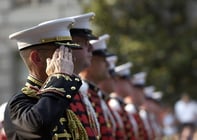Published on
Dissecting “Military Friendly” in Today’s Higher Education Environment

In the rush to support military and veteran students, or simply to cash their checks, many colleges and universities apply the label “military-friendly” to their programming in hopes of appealing to potential and current students. Less understood, however, is any agreed upon definition of what the term means or how it should be used. Is a school “military-friendly” if it is approved for GI Bill benefits? If it has a student veteran lounge?
In my own experiences as a student affairs practitioner, I have seen a lack of sincere commitment to military-affiliated students across most colleges and universities, including elite institutions. A true military-friendly approach involves a focus on compliance, transparency and support in order to ensure military-affiliated students have the highest likelihood to succeed.
While most schools would like to reap the financial benefits of enrolling students with VA or Department of Defense education benefits, strict compliance with regulations is essential to a truly military-friendly environment. Manuals such as VA’s School Certifying Official Handbook give relatively clear answers on how to correctly handle the school’s administrative functions of certifying VA benefits.
Sadly, most schools dramatically underinvest in the staff necessary to certify these benefits correctly. As a best practice, schools dedicated to appropriately serving this community should employ roughly one staff member for every 250-350 military-affiliated students. Furthermore, enough of these staff members need to be hired and well trained to correctly explain these complex and arcane benefits to the students who intend to use them. Having staff that certify benefits removed from the student support staff who explain them is a recipe for both poor student service and compliance mistakes, as key information related to degree pursuit is not always passed from the student back to the certifier.
All too often, transparency is another area lacking in self-proclaimed “military-friendly” institutions, through either sclerotic practices or outright dishonesty. Institutions like Corinthian Colleges, ITT Educational Services, and others in the for-profit space have been pursued for abusive recruiting practices toward student veterans. Additionally, some ostensibly private, non-profit institutions such as Bellevue University have been the subject of transparency complaints as well. Actions like President Obama’s Executive Order 13607, the so-named Principles of Excellence, have been a small step forward in providing more clarity to service members and veterans about the true cost of their education. Unfortunately, attempts like the Department of Education’s 8 Keys to Veterans’ Success to move universities further toward transparent and supportive service have been voluntary, and thus, toothless.
Finally, the third piece of a truly military-friendly university is the level of dedicated, proactive support on offer. To be sure, service members and veterans are used to an environment of great bureaucratic difficulty and inertia. But another hallmark of military service is the presence of generally very accessible first-line supervisors and support staff. Service members are assessed constantly on their ability to perform their mission, and issues which hinder that ability are addressed as quickly as possible to ensure a functioning unit.
Colleges and universities without adequate staff dedicated to be a sole point of contact for military-affiliated students are leaving those students without the support they are used to. Furthermore, as a majority of military-affiliated students fall into a non-traditional demographic, it is more important than ever to ensure a smooth transition process into an unfamiliar higher education environment.
When universities focus on a “whole-student” approach to education, focus is given to every aspect that could hamper a student’s performance. If a student is unhealthy, unhappy or unprepared, they are also unlikely to graduate or remain enrolled for long. Institutions like mine at the University of Nebraska at Omaha, which provide comprehensive approaches to student veterans that start before the first semester begins, experience much higher returns on investment than those that position themselves near a base and advertise heavily.
Support can also extend beyond the presence of adequate staffing into dedicated facilities for military-affiliated students. Colleges and universities with comfortable and well resourced lounges provide a place for student veterans to congregate and engage with each other. Many transitioning service members face a difficult time replacing the peer networks they were so heavily involved in while in service. The more opportunities these students have to network and socialize with their colleagues, the more likely they are to remain enrolled and a member of the campus community.
While none of the components of a true military-friendly approach to higher education are without significant cost, all of them are cost effective. Universities that make these investments will experience significant increases in enrollment, retention and graduation. Additionally, adequate numbers of well trained staff certifying VA benefits bring in large amounts of revenue to the institution, and reduce compliance errors that can result in fines, negative press attention and student turmoil.
For institutions that wish to be considered truly military-friendly the roadmap to that outcome is clear. What is less apparent is if the will to pursue it is present in all institutions that seek to apply the label.
The views and opinions expressed in this article are the author’s own.
Author Perspective: Administrator



